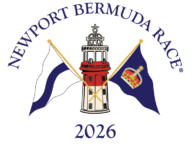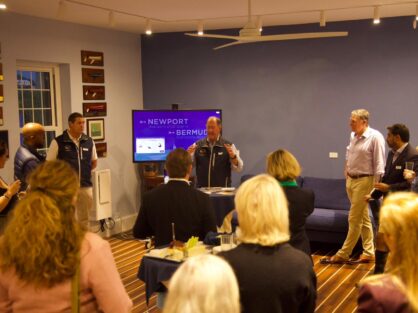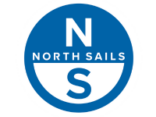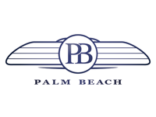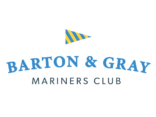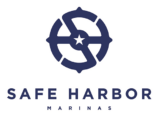On July 2nd, during the return delivery from the 2024 Newport Bermuda Race, the crew of Solution abandoned their 50-foot sloop, 200 miles south of Cape Cod, and were safely rescued by US Coast Guard Helicopter.
2024 has been an unprecedented year of ship abandonments. We are grateful for the safety of all sailors involved and their willingness to share their stories, allowing others to learn and benefit from their experiences.
The following was written by Carter Bacon, Owner and Captain of s/v Solution.
Solution was a 50-foot sloop, designed by K. Aage Nielsen and built by Paul Luke of East Boothbay, Maine, in 1963. She was expertly designed and solidly constructed for racing offshore in the North Atlantic, with 2 x 2 laminated 8 ply white oak frames, double planking of 7/8 mahogany over 3/8 cedar, bronze floor timbers and reinforcing members, and a plywood deck with fiberglass sheathing. She has been maintained since 2000 to the highest standards by Rockport Marine, and has had undergone extensive replacement of structural members on numerous occasions whenever any questions as to her soundness were revealed by annual inspections.
I sailed Solution, with a crew of seven others, to Bermuda in the Newport to Bermuda race, which began on June 21. We arrived in Bermuda on June 25 after a fast, uneventful passage.
On June 29, I departed Bermuda at 3:00 pm with my daughter Libby for the return passage to Solution’s home port of Rockport, Maine. We had two additional sailors aboard, Louise and Clive Crooks. I did not know them but had interviewed them on Zoom. They were companiable and helpful and turned out to be cool and competent when the chips were down. We planned to sail north using modern weather prediction and communications tools to navigate as efficiently as possible through the anticipated Gulf Stream currents and weather patterns. My regular navigator, Jim Gabriel, assisted us with up to the minute weather plots and sailing directions which he sent from his home by satellite phone text messages. At all times while on deck the crew wore harnesses with inflatable PFD’s, and were tethered to jack lines or strong points.
Another vessel which had participated in the race, Orion, left at approximately the same time and was visible to us on AIS for the entire passage. On the morning of July 1, Orion hailed us on VHF channel 16 and the caller introduced himself as “Forrest,” captain of Orion’s return crew. He said they were heading for Boston, and said we should feel free to call on Orion for assistance at any time. I thanked him and offered the same.
The passage began with moderate southerly breezes, coming from directly behind us as we headed north. The wind was insufficient to give us the desired speed and we proceeded under power with the mainsail set, making about six knots. We were carrying a roller-furled genoa jib on our headstay, which we deployed from time to time with little effect. As of 7 pm on June 30, we were 150 miles north of Kitchen Shoals reef, having averaged six knots since our departure.
During the next three hours the southerly breeze freshened until we were able to shut off the engine. Over the same period we picked up a northerly “warm eddy” current of at least two knots. Our speed increased dramatically. We often hit ten knots and we had uninterrupted good
sailing under the mainsail alone for the next 24 hours. At 5 pm on July 1 we were 325 miles north of Kitchen Shoals, having covered 175 miles in the previous 22 hours for an average speed of almost eight knots.
At that time we were experiencing steady winds of more than 20 knots. We were still sailing with a full mainsail and had rolled out the genoa which was giving us added speed. The forecast indicated that winds would increase to 25 knots and then decrease and shift into the west over the next 12 hours, followed by increasing winds as we neared our planned exit from the Gulf Stream. Around 6 pm, as a precautionary measure, I put a double reef in the mainsail and we rolled in the genoa, leaving only a small handkerchief rolled out for balance.
Clive and Louise went below at about 7 pm leaving Libby and me on watch. Once below, Clive slipped as the boat lurched and hit his head on a cabin handhold. He told Louise and me that he was OK. In hindsight, it appears that he suffered a concussion. He went to bed shortly after the fall.
The passage proceeded uneventfully, except for two hours of torrential rains, until early in the morning on July 2. By this time we had left the warm eddy and entered a northbound meander of the Gulf Stream, which gave us the continued benefit of a northerly current. After midnight, the strong winds which had been pushing us steadily northward abated somewhat and shifted from south to west, creating difficult sailing conditions, with confused seas. In response we started the engine, which gave us the power we needed to punch through the waves. I did not increase sail, expecting that strong winds would again materialize. The “ride” was uncomfortable. We bounced around, but there was no pounding and we continued to make good time because we were riding a favorable current at the edge of the Gulf Stream. Around 1 am I felt confident enough about the way the boat was behaving to go below. Clive and Louise came up to take a turn on watch, and Libby and I turned in. Clive said he felt OK, with only a slight headache.
At 3:30 am, after a few hours of motor-sailing, the engine shut down. The cause was probably sludge from the bottom of the fuel tank stirred up by all of the bouncing around. The engine started revving and slowing, a sign that its fuel supply was being choked off. It stopped on its own before it could be shut it down. In a calm harbor with no rolling I could replace the fuel filter and get the engine back on line in twenty minutes. In a choppy sea, getting the engine restarted would be an almost impossible challenge. It would have to wait. We continued to sail without incident, although at a reduced speed now that we had lost the engine. At about 4:00 am I joined Clive on watch in the cockpit. Louise retired to the cabin.
I decided that we should head for Cape Cod, then 230 miles away, which was the closest shelter. This would take a day and a half off the time it would take us to get to a safe harbor. I did not think I had a realistic chance of getting the engine running and it would be only a matter of time before our batteries would run low if they could not be charged. It seemed dangerous to try to get all the way to Rockport.
As the morning progressed the wind continued to shift, as predicted, into the north. We were sailing close hauled on the port tack in an ever more easterly direction. At some point I tacked,
in order to put the boat on a westerly course towards Cape Cod. This course would also take us out of the Gulf Stream which promised to become more turbulent as the wind increased. I hoped we would get a favorable shift at some point that would allow us to fetch the Pollock Rip Channel into Nantucket Sound without tacking. I also considered sailing directly to Newport if we could not fetch the Cape.
After the sun rose, I set up the inner headstay and set a “staysail” (small jib) on that stay, providing Solution with a balanced sail profile that served the boat well in a wide range of wind conditions. Clive was on the helm during these operations, which consumed at least half an hour. He steered well, keeping the boat reasonably level and avoiding crashing seas, so that I could work on the pitching foredeck. Once the staysail was set, Clive retired to the cabin and Libby joined me on watch. It was around 6 am.
Shortly after Clive retired, Louise popped her head up through the companionway to tell me that Clive was nauseous and appeared to have a concussion, but he was conscious, calm and cheerful. Louise had him tucked into his bunk and was caring for him. She was cool, collected and all business. Clive was in good hands. The wind was increasing. I concentrated on trying to steer around the worst of the waves.
By 7 am, the wind had increased substantially. The current was running fast (almost four knots) indicating that we were near the northern “wall,” or boundary, of the Stream, where the current runs the fastest. The waves coming from the north were being “stacked up” by the southerly current. As we ascended a wave, Solution would occasionally come down hard, with a loud bang, rather than the easy landing we are accustomed to. This meant she was landing more on her side than on her bottom. Two of these “bangs,” which came sometime before 7:30 am, were the loudest and most bone-jarring I have ever experienced on any boat. I now believe that these hard landings opened a seam in Solution’s hull.
Suddenly, shortly after the last, and largest, of our hard landings, we were in calmer seas. Our instruments indicated that we had exited the Gulf Stream. The waves were still large and turbulent but they were spaced out to their normal distance and we were sailing fast upwind with easy motion under a double reefed main and small staysail. However, the wind was also rising, to a steady 26 knots, with gusts to 30. The boat was heeled way over and I felt there was too much pressure on the rig. I dropped the mainsail, the boat’s angle of heel decreased, and we were sailing comfortably and with plenty of speed with just a staysail (a small jib), something Solution had done on a number of previous passages in similar conditions. We were just fetching Cape Cod.
After dropping the main and sailing for a few minutes under the staysail alone, I felt confident enough about our sailing situation to hand the helm over to Libby and go below to check on Clive and Louise. It was a little after 8 am.
Clive and Louise were secure in their pilot berths, but the cabin looked like a bomb had hit. All kinds of gear and clothing crammed the floor of the cabin where it had fallen during the time spent battling the waves. I heard water sloshing below the floorboards. I opened the engine compartment at the rear of the cabin and could see that the water was quite deep in the bilges. I was not too concerned at first because the automatic bilge pump had been off, so I turned it on, expecting that the water would be pumped out in less than ten minutes (based on many previous experiences).
I quickly picked up the cabin sufficiently to remove any hazards. I was then able to lift the floorboards around the cabin and check all the through-hull fittings that admitted sea water for various purposes. These all appeared in proper order with hoses attached. However, the bilges were so full of water I could not detect if and where any water might be entering the boat.
Then I went back to the engine compartment to check on the pumping progress. The water had risen, not fallen, in spite of the high-capacity pump. As I watched, our emergency pump, located just above the primary pump, was activated when the water level reached its float switch, but the level kept rising, although at a slower rate because we now had two large pumps going. I do not recall the exact capacity of these pumps, but they could each pump hundreds of gallons per hour, a number that seemed astounding to me when I installed them several years ago. I checked to make sure they were both running and then began a second search for the source of such a large leak. By then there was no way to even guess where the water was coming in. All of the bilge was under water and water was coming over the leeward floorboards when we rolled. It could have been coming from anywhere.
I was out of options. At 8:36, I called my brother Wells, an experienced pilot and sailor, on the Iridium satellite phone (which worked like a charm! What a relief!). I told him the situation and asked him to notify the Coast Guard and take charge of all communications. Minutes later he called back with a phone number to a CG officer. I called the number and was advised that an airplane and helicopter were being dispatched from Cape Cod, 200 miles away. The officer directed me to activate Solution’s EPIRB beacon. I did so at about 9:00 am and placed the unit in a cup holder in the cockpit. I did not secure it to the boat.
After speaking with the Coast Guard I tried calling Orion, the vessel that had been sailing near us since we left Bermuda, but got no response. Later in the morning Orion heard the radio chatter and broke in, offering to come to our aid. The CG pilot in charge thanked them for the offer and asked them to stand by. I then called them and thanked them for their concern. They had not heard my earlier call because they were busy on deck. Two hours later, as I was making the decision to abandon Solution, Orion appeared on the horizon.
The plane arrived around 10:00 am and dropped the pump in the water near us. It had a 400-foot floating rope attached which should have made it easy for us to sail close to it, pick up the rope and reel in the pump container. However, when I tried to maneuver close to the rope I found the boat unresponsive. We sailed right over the rope and then spent an hour trying to maneuver back to it in the high winds and large waves. Solution was so sluggish she would not come up to the wind for a tack. Each time I wanted to change directions I had to jibe, losing any windward distance I might have gained. Later, I realized that we were so full of water that the kind of steering required was impossible because the boat was so sluggish.
After we spent more than an hour or more trying to retrieve the pump, the CG pilot who was flying circles overhead radioed to say that the helicopter would arrive soon, that it was at its maximum distance from base and carried only enough fuel to stay overhead for 50 minutes. He advised us that our choices were to abandon Solution or allow the helicopter to deliver a second pump directly onto our deck. There was not enough time to do both. It was my choice.
It was an easy but painful decision to abandon Solution. She was clearly sinking. I estimated that the water was rising an inch every ten minutes and it was now completely covering the floorboards, with 8 inches to go before it covered the main batteries located beneath the lower bunks in the main cabin. This could be two to six hours away. Once the batteries were submerged there was no way to know whether or for how long they would continue to provide power to the electric pumps before shorting out. Even if we got the bigger pump aboard and it got ahead of the flooding, we would still have to make it 200 miles without a pump failure through heavy adverse winds and seas, which were not expected to abate until late on July 3. There was no hope of restarting the engine until we reached calm water which meant that the batteries could not be charged to power our pumps, assuming we could keep them from becoming submerged. I assumed we had hull damage and had no way to assess its extent or the increased rate of flooding that would result if we started to push the hull. If that wasn’t enough, there was a crewmember on board with a possible concussion. We had no choice but to go. I told the CG pilot we would be ready to move immediately when the helicopter arrived.
When the helicopter arrived, the pilot directed me to turn 180 degrees and place the boat on an easterly course. After making this turn, the staysail was backed, with the sheet pulling from the windward side. The boat moved along steadily at 1-3 knots, without any further need for steering, allowing the helicopter pilot to gauge his approach.
The actual rescue was at once dramatic and anti-climactic. Each of us jumped in the water in turn. A frogman was lowered, harnessed up the “victim” and the pair was hoisted 80 feet to the helicopter. I had watched this so many times on TV that there was nothing surprising except the tight grip of the harness. The competence and coordination of the CG crew was, not surprisingly, as close to perfection as humans get. The process was repeated four times and the pilot headed for Cape Cod at approximately 12:15 pm.
Although Clive was suffering from a possible concussion, he had no problem getting into his safety gear, coming up on deck, jumping over the side and ascending to the helicopter. As soon as he was aboard, CG personnel examined him and performed various tests while in radio contact with a physician.
